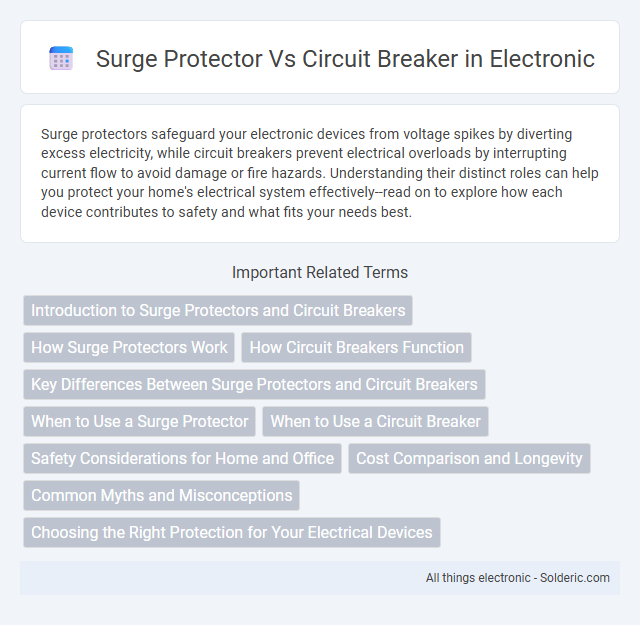Surge protectors safeguard your electronic devices from voltage spikes by diverting excess electricity, while circuit breakers prevent electrical overloads by interrupting current flow to avoid damage or fire hazards. Understanding their distinct roles can help you protect your home's electrical system effectively--read on to explore how each device contributes to safety and what fits your needs best.
Comparison Table
| Feature | Surge Protector | Circuit Breaker |
|---|---|---|
| Primary Function | Protects devices from voltage spikes and surges | Interrupts electrical flow to prevent overload and short circuits |
| Protection Type | Voltage surge and transient protection | Overcurrent and short circuit protection |
| Location | Connected to power outlets or power strips | Installed in electrical panels |
| Operation | Diverts excess voltage to ground | Trips and cuts power during fault |
| Reset | Usually automatic or replaceable modules | Manual reset required |
| Lifespan | Limited; depends on surge events | Long-lasting with proper use |
| Cost | Lower cost | Higher upfront cost |
| Examples | SPD (Surge Protective Device), MOV-based protectors | Thermal-magnetic breakers, GFCI breakers |
Introduction to Surge Protectors and Circuit Breakers
Surge protectors safeguard your electronic devices by diverting excess voltage caused by power surges, preventing damage from lightning strikes or electrical spikes. Circuit breakers protect electrical circuits from overloads by automatically interrupting current flow in case of excessive demand, reducing fire risks. Understanding the difference between surge protectors and circuit breakers helps you choose the right device for protecting both your appliances and home wiring system.
How Surge Protectors Work
Surge protectors work by diverting excess voltage from power surges away from connected devices, using components like metal-oxide varistors (MOVs) that absorb and dissipate the transient energy. Unlike circuit breakers that interrupt electrical flow during overcurrent conditions, surge protectors continuously monitor voltage levels and respond instantly to spikes, preventing damage to sensitive electronics. Effective surge protection minimizes the risk of costly failures caused by lightning strikes, power outages, or fluctuating utility power.
How Circuit Breakers Function
Circuit breakers function by automatically interrupting electrical flow when a fault or overload is detected, preventing damage and fire hazards. They monitor current levels and trip the switch when the current exceeds a predetermined safe threshold. Unlike surge protectors that shield devices from voltage spikes, circuit breakers protect entire electrical circuits by disconnecting power during dangerous conditions.
Key Differences Between Surge Protectors and Circuit Breakers
Surge protectors safeguard electronic devices by diverting excess voltage from power surges, whereas circuit breakers prevent electrical overloads and short circuits by interrupting the current flow. Surge protectors operate based on voltage spikes and typically use components like metal-oxide varistors (MOVs), while circuit breakers mechanically open the circuit when current exceeds a preset limit. Understanding these fundamental differences helps ensure proper protection and safety in residential and commercial electrical systems.
When to Use a Surge Protector
Use a surge protector to safeguard your electronic devices from sudden voltage spikes caused by lightning strikes, power outages, or switching operations. It is essential for sensitive electronics such as computers, televisions, and home theater systems, where voltage surges can cause irreversible damage. Your investment in surge protectors helps extend the lifespan of these devices by preventing electrical surges from reaching your valuable equipment.
When to Use a Circuit Breaker
Use a circuit breaker when protecting entire electrical circuits from overloads or short circuits in residential or commercial buildings. Circuit breakers automatically interrupt current flow to prevent wiring damage and fire hazards during excessive current conditions. They are essential for safely managing the main electrical panel and ensuring compliance with electrical codes.
Safety Considerations for Home and Office
Surge protectors prevent electrical spikes from damaging sensitive electronics by diverting excess voltage, making them essential for protecting computers, televisions, and home office equipment. Circuit breakers safeguard homes and offices by interrupting power flow during overloads or short circuits, preventing electrical fires and equipment damage. Combining surge protectors with reliable circuit breakers enhances overall electrical safety and ensures comprehensive protection against both voltage surges and electrical faults.
Cost Comparison and Longevity
Surge protectors typically cost between $20 and $100, offering affordable protection against voltage spikes, while circuit breakers range from $50 to $200 depending on the amperage and type, reflecting their critical role in electrical safety. Surge protectors have a limited lifespan, often needing replacement every 3 to 5 years after absorbing multiple surges, whereas circuit breakers can last 30 years or more with proper maintenance. Your investment in a circuit breaker provides long-term durability, while surge protectors require periodic replacement to maintain effective protection at a lower initial cost.
Common Myths and Misconceptions
Surge protectors and circuit breakers serve distinct purposes, yet many mistakenly believe they provide the same level of electrical protection. Surge protectors guard against voltage spikes that can damage electronic devices, whereas circuit breakers prevent electrical overloads and short circuits by interrupting power flow. Confusing these functions can lead to inadequate safety measures and increased risk of equipment damage or fire hazards.
Choosing the Right Protection for Your Electrical Devices
Surge protectors shield your electrical devices from voltage spikes by diverting excess electricity, while circuit breakers prevent overloads and short circuits by interrupting current flow. Choosing the right protection depends on your specific needs: surge protectors are ideal for safeguarding sensitive electronics, whereas circuit breakers ensure overall system safety by managing electrical faults. For comprehensive defense, integrating both devices in your electrical setup optimizes protection and prolongs the lifespan of your equipment.
surge protector vs circuit breaker Infographic

 solderic.com
solderic.com